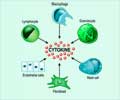Leprosy is an infectious disease that affects the skin and peripheral nerves and is caused by Mycobacterium leprae and, less commonly, Mycobacterium lepromatosis.

‘There are several drugs being tested that inhibit the production of nitric oxide, and the key may be to catch the disease at an early enough stage to prevent damage to the nerve cells.’





Despite the disease having been known about for thousands of years many people will have first heard about it through references in the Bible very little is understood about its biology.This is in part because the bacteria are difficult to grow in culture and there are no good animal models: M. leprae can grow in the footpads of mice, but do not cause nerve damage; the disease causes nerve damage in armadillos, but these animals are rarely used in research.
Now, an international team led by researchers at the University of Cambridge, UK, and the University of Washington, the University of California Los Angeles and Harvard University, USA, have used a new animal model, the zebrafish, to show for the first time how M. leprae damage nerves by infiltrating the very cells that are meant to protect us.
Zebrafish are already used to study another species of mycobacteria, to help understand tuberculosis (TB).
Scientists have previously shown that the nerve damage in leprosy is caused by a stripping away of the protective insulation, the myelin sheath, that protects nerve fibres, but it was thought that this process occurred because the bacteria got inside Schwann cells, specialist cells that produce myelin.
Advertisement
When they injected bacteria close to the nerve cells of the zebrafish, they observed that the bacteria settled on the nerve, developing donut-like 'bubbles' of myelin that had dissociated from the myelin sheath.
Advertisement
"These 'Pac-Man'-like immune cells swallow the leprosy bacteria, but are not always able to destroy them," explains Professor Lalita Ramakrishnan from the Department of Medicine at the University of Cambridge, whose lab is within the Medical Research Council's Laboratory of Molecular Biology.
"Instead, the macrophages which should be moving up and down the nerve fibre repairing damage slow down and settle in place, destroying the myelin sheath."
Professor Ramakrishnan working with Dr Cressida Madigan, Professor Alvaro Sagasti, and other colleagues confirmed that this was the case by knocking out the macrophages and showing that when the bacteria sit directly on the nerves, they do not damage the myelin sheath.
The team further demonstrated how this damage occurs. A molecule known as PGL-1 that sits on the surface of M. leprae 'reprograms' the macrophage, causing it to overproduce a potentially destructive form of the chemical nitric oxide that damages mitochondria, the 'batteries' that power nerves.
"The leprosy bacteria are, essentially, hijacking an important repair mechanism and causing it to go awry," says Professor Ramakrishnan. "It then starts spewing out toxic chemicals. Not only does it stop repairing damage, but it creates more damage itself."
"We know that the immune system can lead to nerve damage - and in particular to the myelin sheath - in other diseases, such as multiple sclerosis and Guillain-Barré syndrome," says Dr Cressida Madigan from the University of California, Los Angeles. "Our study appears to place leprosy in the same category of these diseases."
The researchers say it is too early to say whether this study will lead to new treatments. There are several drugs being tested that inhibit the production of nitric oxide, but, says Professor Ramakrishnan, the key may be to catch the disease at an early enough stage to prevent damage to the nerve cells.
"We need to be thinking about degeneration versus regeneration," she says.
"At the moment, leprosy can be treated by a combination of drugs. While these succeed in killing the bacteria, once the nerve damage has been done, it is currently irreversible. We would like to understand how to change that. In other words, are we able to prevent damage to nerve cells in the first place and can we additionally focus on repairing damaged nerve cells?"
Source-Eurekalert










